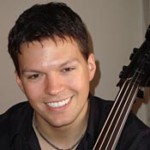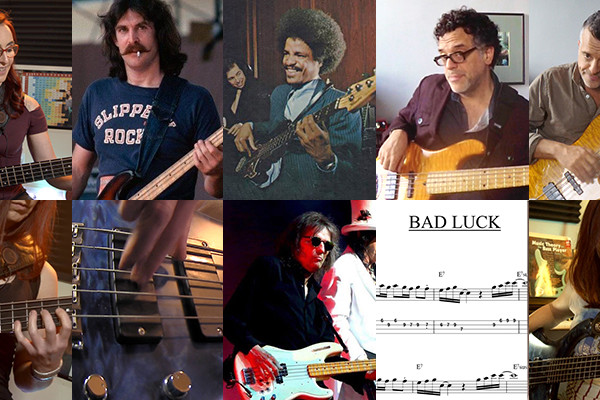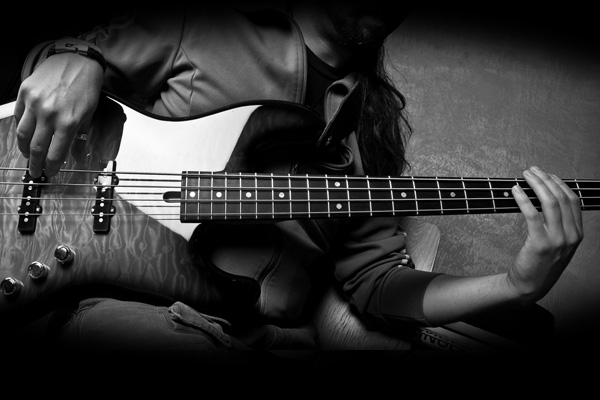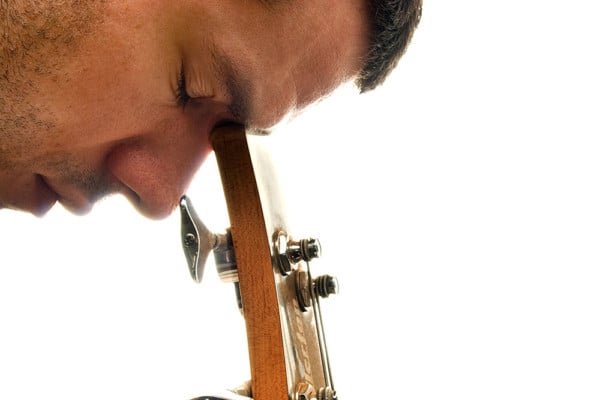The Zen of Ear Training – Part 1

An important part of every musician’s evolution is ear training. It’s a strange concept, but becoming an active and educated listener pays off in a huge way. First lets cover a few points about what ear training is and isn’t and then we’ll get to the exercises. Ear training is a broad term used to cover two aural developmental practices – perfect pitch and relative pitch. A common misconception we’ve got to dispel right away, perfect pitch is learnable, but your expectations need to be reasonable. Learned perfect pitch is a very subtle thing. It’s not that you suddenly can call out every note in every tune; rather it gives you a deeper perception of music. The best analogy is to think of describing different shades of color to people.
Relative pitch is equally important (and more-so for certain types of playing) and is the art of hearing the relationships between tones even if you don’t know the exact note e.g. minor third, descending diatonic scale, etc. This is also learnable with practice.
Ear training will not diminish your ability to enjoy music. Incredibly, I’ve heard other musician’s say “I don’t want [insert “perfect pitch / trained ears”], it means I won’t enjoy music anymore.” WHAT??!! That’s like saying you don’t want to see color because it diminishes your ability to enjoy art. I think this is an excuse because ear training can be abstract and difficult, do not believe this. If you make a regular point to practice ear training it will pay off.
I’ll admit that ear training is difficult for me. As a grounded bassist and otherwise instrumental player I don’t really relish the idea of singing a lot… that’s why I’m an instrumentalist, and why no videos are included with this lesson (believe me it’s for the better). Over time I’ve found that these exercises have been extremely useful in my musical development. I make a point to do singing exercises regularly (and I am NOT a trained singer by any stretch of the imagination) and it gets easier over time. Remember that these are all a process of refinement. If you can tell that a bird chirping is higher than a dog barking you can learn this, we just have to work to where our ears can distinguish finer and finer pitch differences.
Finally, why bother? In the gigging world the musician with the “biggest” ears wins. If you have developed your ability to hear quickly and accurately, you’ll never be lost in a tune and you can get through most obstacles in a gig on the spot. Good ears = lots of gigs. Also transcription will become much easier and this is one of the most important steps in developing a soloing style for jazz.
For this lesson the exercises are very sequential. Each one builds on the abilities learned in the last. These are also very plain-clothes, salt-of-the-Earth, non-flashy drills. I like to think of them as musical meditation. Without sounding too corny, seriously try to clear your mind and immerse yourself in the individual tones, there’s a lot of subtlety here. Part two will take this another step farther, so make a point to work on these exercises in preparation for more.
Exercise 1:
Sing a scale. This is the classic Do-Re-Mi drill from grade school, if you don’t remember the notes it goes like this:
Do Re Mi Fa Sol La Ti Do
This is important though, you have to be able to sing these tones in key. Play along with your instrument as you sing these scales. Just make it part of your practice routine, anytime you play a scale you sing it as well.
Exercise 2:
Once you feel comfortable that you can sing a scale in tune, focus on each interval. For example sing and play the following at 40 bpm, changing notes every 2 clicks:
Do Re Do Re Do Re Do Re Do Re
Doing it over such a long interval is important, you need to really let your ears soak in each tone. Now once you have that down, repeat it but only play “Do” on your bass. You’ll be singing Do Re Do Re Do Re while your bass is sounding a consistent Do Do Do Do Do – creating a drone. I cannot stress enough how important this boring simple exercise is to your ear development. You really need to meditate on each note, we have some serious bass zen going on but this is what it takes.
Exercise 3:
Remember this is all about development, which happens slowly. Repeat exercise 2, but do it with each interval in the diatonic scale. That means you do Do Re, then do Do Mi, then Do Fa etc, each to completion. Start small, pick one interval a day to start and dedicate yourself to spending 10 minutes on it. So Sunday would be Do/Re, Monday Do/Mi, Tuesday Do/Fa and so on. Set a timer ;)
Again this is all to get your ear used to distinguishing the subtleties between the pitches. Try to pick out one thing that differentiates the tones from each other. For example when I compare an F# and and Eb the F# has a more twangy sound to it. My best typed rendition would be “rrrwaanng rrrwaanng rwaaang” underneath the actual pitch. With an Eb I hear a more “woooooaaaa wooooaaaa woooooaaa” – it’s a very delicate difference but it’s there, and that’s what you have to hear and take notice of in this exercise. If you don’t hear anything that stands out, don’t try to force it. Continue with the exercise and come back to it another day, you want the subtlety to be something that is noticeable to you without intense effort.
Write down your “identifying subtlety” for each note. Some people find it useful to associate the tones with colors, others don’t. The important thing is that you identify something about each tone that sets it apart. This is the first step to developing perfect pitch.
Exercise 4:
Exercise 3 is great for really getting inside the tones, after you do it for a week or two you can start to streamline the procedure just to keep your ears “refreshed.” Now keep the metronome at 40bpm, but count in 4/4 meter (one beat per click). Now sing exercise 3 with each diatonic interval getting one measure. This means you’ll have:
Do Re Do Re | Do Mi Do Mi | Do Fa Do Fa | Do Sol Do Sol | ….
When you hit the octave, sing coming back down referencing the higher Do (the octave tone). Ascending you have Low-High (in terms of the pitch relationships), descending you’ll have High-Low (since the octave is the highest).
Exercise 5:
Repeat Exercises 1-4 in the different keys. In exercise three you should notice a lot of overlap in your “identifying subtleties” – once you’ve identified a tone as having a particular characteristic try to focus on hearing it when that tone comes up in other keys. For example, an F# should have the “rrrwaanng” sound whether it’s in the key of D, G, E, A or B even though its intervallic relationship is different in each one.
If you have a recording device you can make yourself different practice tracks for different keys to do at different times. For example, make a practice tape for the keys C, G, D and A to work on during your commute to work. Another for E, B, Gb and Db to do during your lunch break and finally one for Ab, Eb, Bb and F to do on your commute back home. You’d have all twelve keys covered without losing any of your normal practice time (assuming you don’t shed and drive…).
There’s a lot going on here, and it’s worth taking the time to do these exercises properly. As musicians how often do we really take the time to immerse ourselves in a single tone’s quality? This is a process of musical discovery! A final note would be don’t try too hard and don’t force it. Eventually your ear will open up, it will be different for everyone and will take time. There’s a reason why lots of musicians don’t have good ears, developing them takes a lot of patience and a lot of practice. Keep at it and in the next lesson we’ll step it up a notch.
Photo by Rrakesh Vaghela




Type your comment here.BRILLIANT! I have spent alot of time with this & feel it is very important! There is a free site that I share with my students: Ricci Adams' (music theory .net) …when there, there's alot of stuff on the menu… the “ear trainers” section is of the hook, if only I did it every day! 3 choices: Intervals modes/scales chords All set up to hear & learn! with a cool grading system that keeps track of what you're doing! I don't know much about who he is but damn it's a cool site!! If any body actually checks this out PLEASE get back to me, let me know what you think.
Thanks! Glad you liked the lesson – there is more to come with ear-training. The music-theory website is interesting, if you're looking for ear-training resources for your students I'd also recommend http://linux-sound.org/ – under the Musician's Utilities section there is a list of ear-training software, some of which can be run in your web-browser.
In my opinion the best method is to work with your own instrument since that's what you're used to hearing. Once you feel comfortable getting a friend to practice with can make sure you don't cheat in testing yourself ;-)
Thanks Evan for getting back to me! Yes I do believe that being able to 'hear' is the most important aspect…but it has to feel natural, like walking into a store while shopping, & they have music on… & you just know the changes…the key isn't as important, but to hear the changes is utmost! I know I don't have prefect pitch, but some times things will jump out at me…the sound of a D major chord in root position, I pretty much always hear it. Also I seem to be very sensitive to a bass note below our open E string, I just hear it…so I guess perfect pitch can be developed, but give me outstanding relative pitch any day & I'm a happy man!!!
…also thanks for the linex link…I saved it & will check it out…
I have a problem here.
I have read this technique for ear training but somehow, I just cant start doing so, since the problem with me is that i cannot hear whether the note i am singing matches the one with the piano, with me first playing the piano, and then trying to sing the note. Am I tone deaf? or am I not trying hard? Is there a way to identify notes?
Gavin – there are a few things you can do to help know that you're landing on the right pitches. If you can tell that a dog barking is different from a bird chirping then you are not tone-deaf. These exercises are not easy and take a lot of time. Something to keep in mind is that “a flower blooms when it's ready” – you can't force your ears to be “good” though you can make sure your practice methods are. Eventually it will all click into place, but it will take some time and consistent work, the results come from the development of small changes over time. I would set your initial goal to be 10-15 minutes of dedicated no-distraction ear training every day, this is better than 60 minutes once a week, biology doesn't always conform to our desired time-tables ;-)
First, try using your finger to block one ear, it will amplify the sound of your voice in your head and may make it easier to hear.
Second, try singing a simple song as you play the piano and lock on to one pitch. For example, playing “Twinkle Twinkle Little Star” and singing along, it should be easier to tell if you're in tune. Hold the last note and focus on that for your pitch training in whatever key you're working with.
Third, if you're still having trouble you can always ask a musically-inclined friend for help. It may feel a little embarrassing to ask, but if it's what will help try to make the plunge. They can do the exercise with you – matching voice-to-voice may be easier than matching voice-to-piano.
Finally, if none of that works, there are tuners out there which can pick up played pitches. If you get your hands on one of these you'll be able to see if your sung notes are in line or not. I use one to test myself for matching pitches from memory (e.g. singing an E without an instrument or guide-note).
I have a problem here.
I have read this technique for ear training but somehow, I just cant start doing so, since the problem with me is that i cannot hear whether the note i am singing matches the one with the piano, with me first playing the piano, and then trying to sing the note. Am I tone deaf? or am I not trying hard? Is there a way to identify notes?
Gavin – there are a few things you can do to help know that you're landing on the right pitches. If you can tell that a dog barking is different from a bird chirping then you are not tone-deaf. These exercises are not easy and take a lot of time. Something to keep in mind is that “a flower blooms when it's ready” – you can't force your ears to be “good” though you can make sure your practice methods are. Eventually it will all click into place, but it will take some time and consistent work, the results come from the development of small changes over time. I would set your initial goal to be 10-15 minutes of dedicated no-distraction ear training every day, this is better than 60 minutes once a week, biology doesn't always conform to our desired time-tables ;-)
First, try using your finger to block one ear, it will amplify the sound of your voice in your head and may make it easier to hear.
Second, try singing a simple song as you play the piano and lock on to one pitch. For example, playing “Twinkle Twinkle Little Star” and singing along, it should be easier to tell if you're in tune. Hold the last note and focus on that for your pitch training in whatever key you're working with.
Third, if you're still having trouble you can always ask a musically-inclined friend for help. It may feel a little embarrassing to ask, but if it's what will help try to make the plunge. They can do the exercise with you – matching voice-to-voice may be easier than matching voice-to-piano.
Finally, if none of that works, there are tuners out there which can pick up played pitches. If you get your hands on one of these you'll be able to see if your sung notes are in line or not. I use one to test myself for matching pitches from memory (e.g. singing an E without an instrument or guide-note).
[…] […]
Great stuff thanks
Really nice, and likely useful exercises. Thank you for this!
There’s a small typo in the Ex.1 the scale should be “Do Re Mi Fa Sol La Si Do” (“SI” instead of “TI”).
Great Job!
Great stuff, Evan! Thank you.